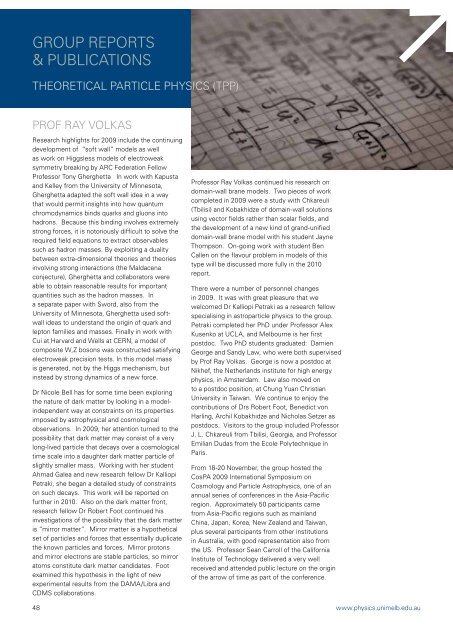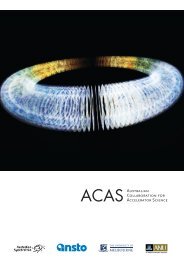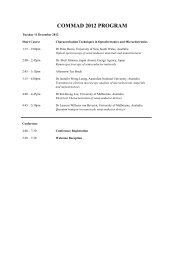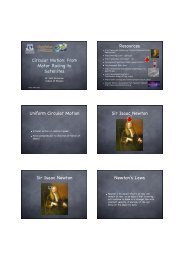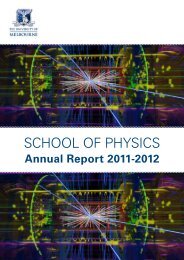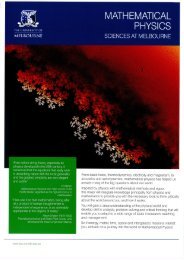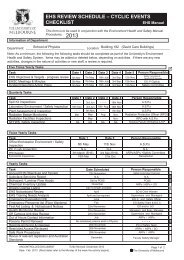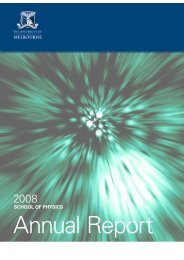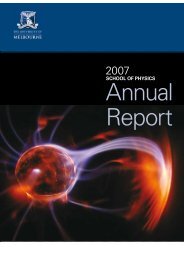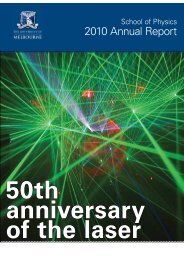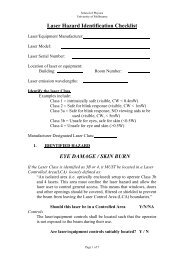Annual Report 2009.pdf - School of Physics - University of Melbourne
Annual Report 2009.pdf - School of Physics - University of Melbourne
Annual Report 2009.pdf - School of Physics - University of Melbourne
- No tags were found...
Create successful ePaper yourself
Turn your PDF publications into a flip-book with our unique Google optimized e-Paper software.
group reports& publicationstheoretical particle physics (TPP)Pr<strong>of</strong> Ray VolkasResearch highlights for 2009 include the continuingdevelopment <strong>of</strong> “s<strong>of</strong>t wall” models as wellas work on Higgsless models <strong>of</strong> electroweaksymmetry breaking by ARC Federation FellowPr<strong>of</strong>essor Tony Gherghetta In work with Kapustaand Kelley from the <strong>University</strong> <strong>of</strong> Minnesota,Gherghetta adapted the s<strong>of</strong>t wall idea in a waythat would permit insights into how quantumchromodynamics binds quarks and gluons intohadrons. Because this binding involves extremelystrong forces, it is notoriously difficult to solve therequired field equations to extract observablessuch as hadron masses. By exploiting a dualitybetween extra-dimensional theories and theoriesinvolving strong interactions (the Maldacenaconjecture), Gherghetta and collaborators wereable to obtain reasonable results for importantquantities such as the hadron masses. Ina separate paper with Sword, also from the<strong>University</strong> <strong>of</strong> Minnesota, Gherghetta used s<strong>of</strong>twallideas to understand the origin <strong>of</strong> quark andlepton families and masses. Finally in work withCui at Harvard and Wells at CERN, a model <strong>of</strong>composite W,Z bosons was constructed satisfyingelectroweak precision tests. In this model massis generated, not by the Higgs mechanism, butinstead by strong dynamics <strong>of</strong> a new force.Dr Nicole Bell has for some time been exploringthe nature <strong>of</strong> dark matter by looking in a modelindependentway at constraints on its propertiesimposed by astrophysical and cosmologicalobservations. In 2009, her attention turned to thepossibility that dark matter may consist <strong>of</strong> a verylong-lived particle that decays over a cosmologicaltime scale into a daughter dark matter particle <strong>of</strong>slightly smaller mass. Working with her studentAhmad Galea and new research fellow Dr KalliopiPetraki, she began a detailed study <strong>of</strong> constraintson such decays. This work will be reported onfurther in 2010. Also on the dark matter front,research fellow Dr Robert Foot continued hisinvestigations <strong>of</strong> the possibility that the dark matteris “mirror matter”. Mirror matter is a hypotheticalset <strong>of</strong> particles and forces that essentially duplicatethe known particles and forces. Mirror protonsand mirror electrons are stable particles, so mirroratoms constitute dark matter candidates. Footexamined this hypothesis in the light <strong>of</strong> newexperimental results from the DAMA/Libra andCDMS collaborations.48Pr<strong>of</strong>essor Ray Volkas continued his research ondomain-wall brane models. Two pieces <strong>of</strong> workcompleted in 2009 were a study with Chkareuli(Tbilisi) and Kobakhidze <strong>of</strong> domain-wall solutionsusing vector fields rather than scalar fields, andthe development <strong>of</strong> a new kind <strong>of</strong> grand-unifieddomain-wall brane model with his student JayneThompson. On-going work with student BenCallen on the flavour problem in models <strong>of</strong> thistype will be discussed more fully in the 2010report.There were a number <strong>of</strong> personnel changesin 2009. It was with great pleasure that wewelcomed Dr Kalliopi Petraki as a research fellowspecialising in astroparticle physics to the group.Petraki completed her PhD under Pr<strong>of</strong>essor AlexKusenko at UCLA, and <strong>Melbourne</strong> is her firstpostdoc. Two PhD students graduated: DamienGeorge and Sandy Law, who were both supervisedby Pr<strong>of</strong> Ray Volkas. George is now a postdoc atNikhef, the Netherlands institute for high energyphysics, in Amsterdam. Law also moved onto a postdoc position, at Chung Yuan Christian<strong>University</strong> in Taiwan. We continue to enjoy thecontributions <strong>of</strong> Drs Robert Foot, Benedict vonHarling, Archil Kobakhidze and Nicholas Setzer aspostdocs. Visitors to the group included Pr<strong>of</strong>essorJ. L. Chkareuli from Tbilisi, Georgia, and Pr<strong>of</strong>essorEmilian Dudas from the Ecole Polytechnique inParis.From 18-20 November, the group hosted theCosPA 2009 International Symposium onCosmology and Particle Astrophysics, one <strong>of</strong> anannual series <strong>of</strong> conferences in the Asia-Pacificregion. Approximately 50 participants camefrom Asia-Pacific regions such as mainlandChina, Japan, Korea, New Zealand and Taiwan,plus several participants from other institutionsin Australia, with good representation also fromthe US. Pr<strong>of</strong>essor Sean Carroll <strong>of</strong> the CaliforniaInstitute <strong>of</strong> Technology delivered a very wellreceived and attended public lecture on the origin<strong>of</strong> the arrow <strong>of</strong> time as part <strong>of</strong> the conference.www.physics.unimelb.edu.au


